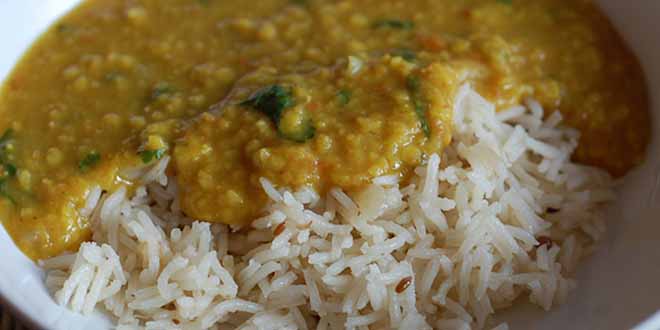
How good is your Daal Chawal?
Health benefits of Rice ‘Chawal’
The Chinese eat rice in every meal, breakfast included, and the average Chinese is thin if not skinny. In our country however we are getting skeptical about rice and yes we are all getting fatter. We either give up rice or switch to wheat or brown rice.
However, replacing rice with wheat is not a good idea since it means reducing your intake of amino acids (protein’s building blocks) and Vitamin B. Brown rice has the outer layer (husk and bran) intact making it high in fiber. Now of course we want fiber, but if your rice has more fiber than you can digest, brown rice will only cause indigestion.
Thus to get the best of both worlds, polish your rice to the extent that it retains its nutrients (protein, vitamins, fiber) and looks brownish or reddish. Remove the outer bran but allow the rice grain to show off its brown/red strains. Don’t worry, this won’t compromise the taste and yes you can eat basmati rice with the brown/red strains as well.
The protein in this rice (red rice or hand polished rice) is absorbed much better by your body than brown rice. It is also way easier to cook and digest as compared to brown rice. It is easy to digest, easy to absorb, easy to assimilate proteins from and easier on your excretory system.
The essential amino acid methionine found pre-dominantly in rice helps mobilize fat from the liver. Getting proteins from rice, especially the essential amino acid methionine and the conditionally amino acid tyrosine (which becomes essential under conditions of stress) is crucial for us. Diabetics should also eat rice since they need these proteins.
Health benefits of Lentils ‘Daal”
Lentils, a small but nutritionally mighty member of the legume family, are a very good source of cholesterol-lowering fiber. Not only do lentils help lower cholesterol, they are of special benefit in managing blood sugar disorders since their high fiber content prevents blood sugar levels from rising rapidly after a meal. Lentils also provide excellent amounts of seven important minerals, B-vitamins and protein – all with no fat.
Lentils, like other beans, are rich in dietary fiber, both the soluble and insoluble types. Soluble fiber forms a gel-like substance in the digestive tract that captures bile (which contains cholesterol) and removes it out of the body. Insoluble fiber not only helps to increase stool bulk and prevent constipation, but also helps prevent digestive disorders like irritable bowel syndrome.
Based on research studies, lentils provide an 82% reduction in coronary heart disease. Lentil’s contribution to heart health lies not only in the fiber content, but also in the significant amounts of folate and magnesium they contain. Folate helps lower levels of homocysteine, an amino acid that is an intermediate product in an important metabolic process called methylation cycle. When folate (as well as vitamin B6) are around, homocysteine is converted into methionine or cysteine, both of which are good for the body. When these B vitamins are not around, levels of homocysteine in the blood increases which damages artery walls and increases the risk of heart disease. Magnesium is nature’s own calcium channel blocker. When enough magnesium is around, veins and arteries breath a sigh of relief and relax, which lessens the resistance and improves the flow of blood, oxygen and nutrients throughout the body.
In addition to its beneficial effects on the digestive system and heart, soluble fiber helps stabilize blood sugar levels. If you have insulin resistance, hypoglycemia or diabetes, legumes like lentils can really help you balance blood sugar levels while providing steady, slow burning energy. A research study between two groups of people were conducted, one group who ate a diet which contained 24 grams of fiber/day and the other group who ate 50 grams of fiber/day. Those who ate a diet higher in fiber had lower levels of both plasma glucose (blood sugar) and insulin (a hormone that helps blood sugar get into cells). The high fiber group also reduced their total cholesterol by nearly 7%, their triglycerides by 10.2% and their VLDL (very low density lipoprotein – the most dangerous form of cholesterol) by 12.5%.
In addition to providing slow burning complex carbohydrates, lentils can increase your energy by replenishing your iron stores. Particularly for menstruating women, who are more at risk for iron deficiency, boosting iron stores with lentils is a good idea, especially because unlike red meat, another source of iron, lentils are not rich in fat and calories. Iron is an integral component of hemoglobin which transports oxygen from the lungs to all body cells and is also part of key enzyme for energy production and metabolism
So how good is your daal chawal really?
Daal chawal is a nutritious meal, possessing the entire spectrum of amino acids, vitamins and minerals. It also accelerates fat burning. A humble portion of daal chawal is so satiating that it makes you eat slower and improves your chances of eating the right amount (the cornerstone of fat loss or accelerated metabolism, good digestion, and health itself)

